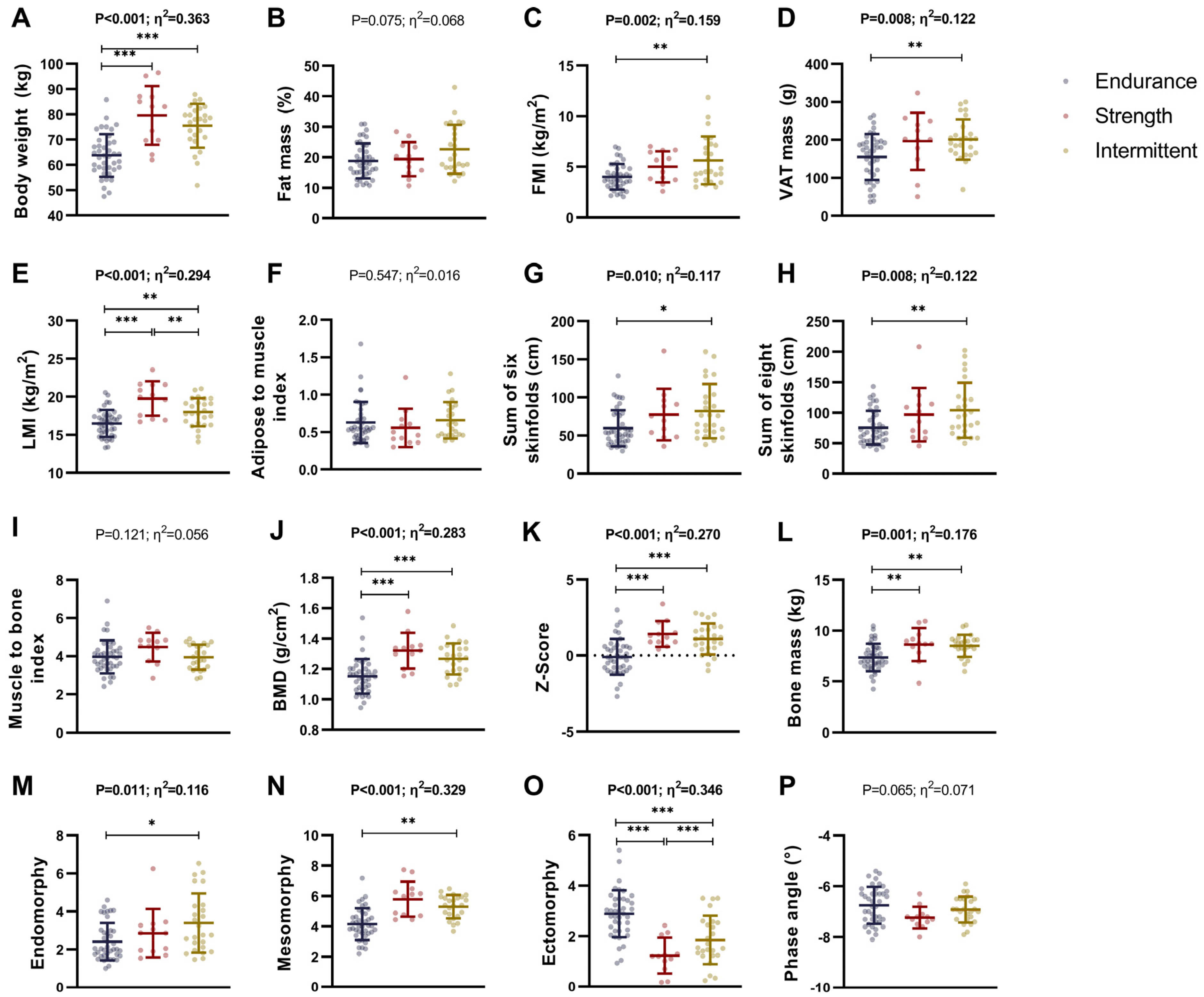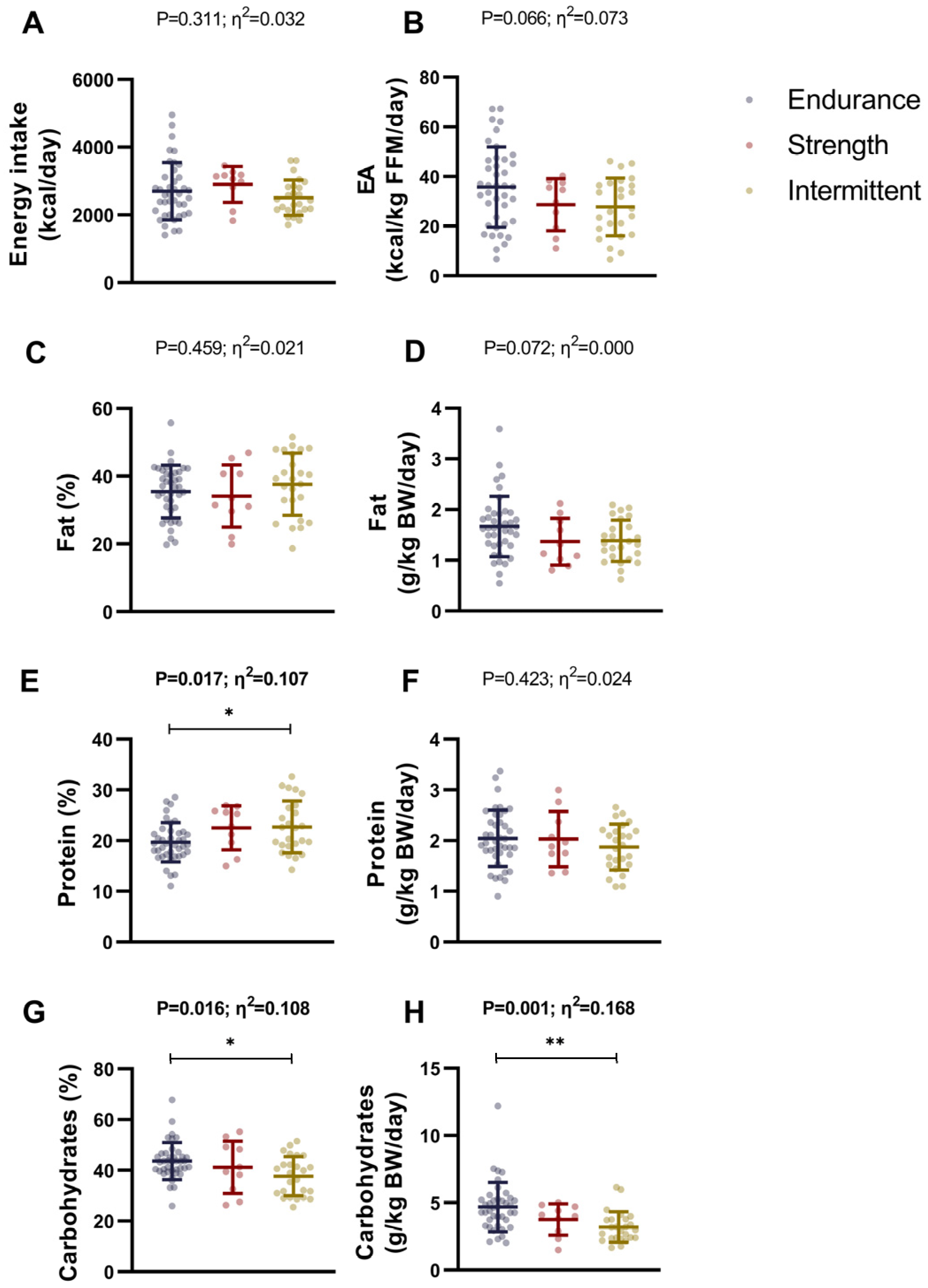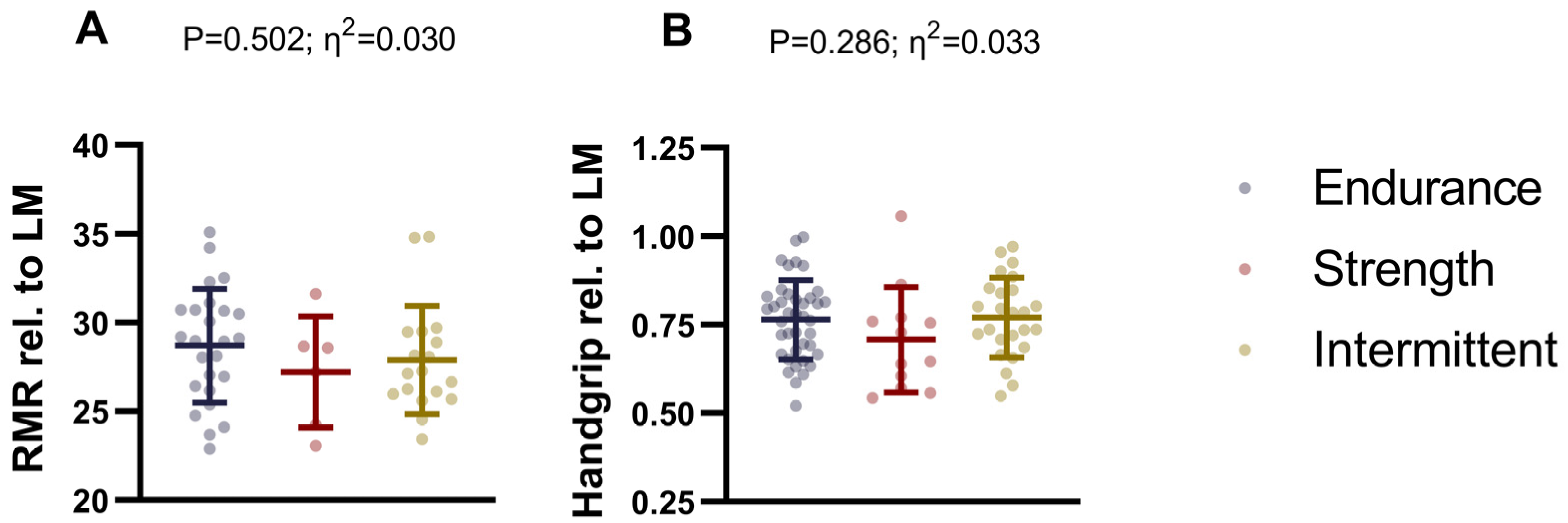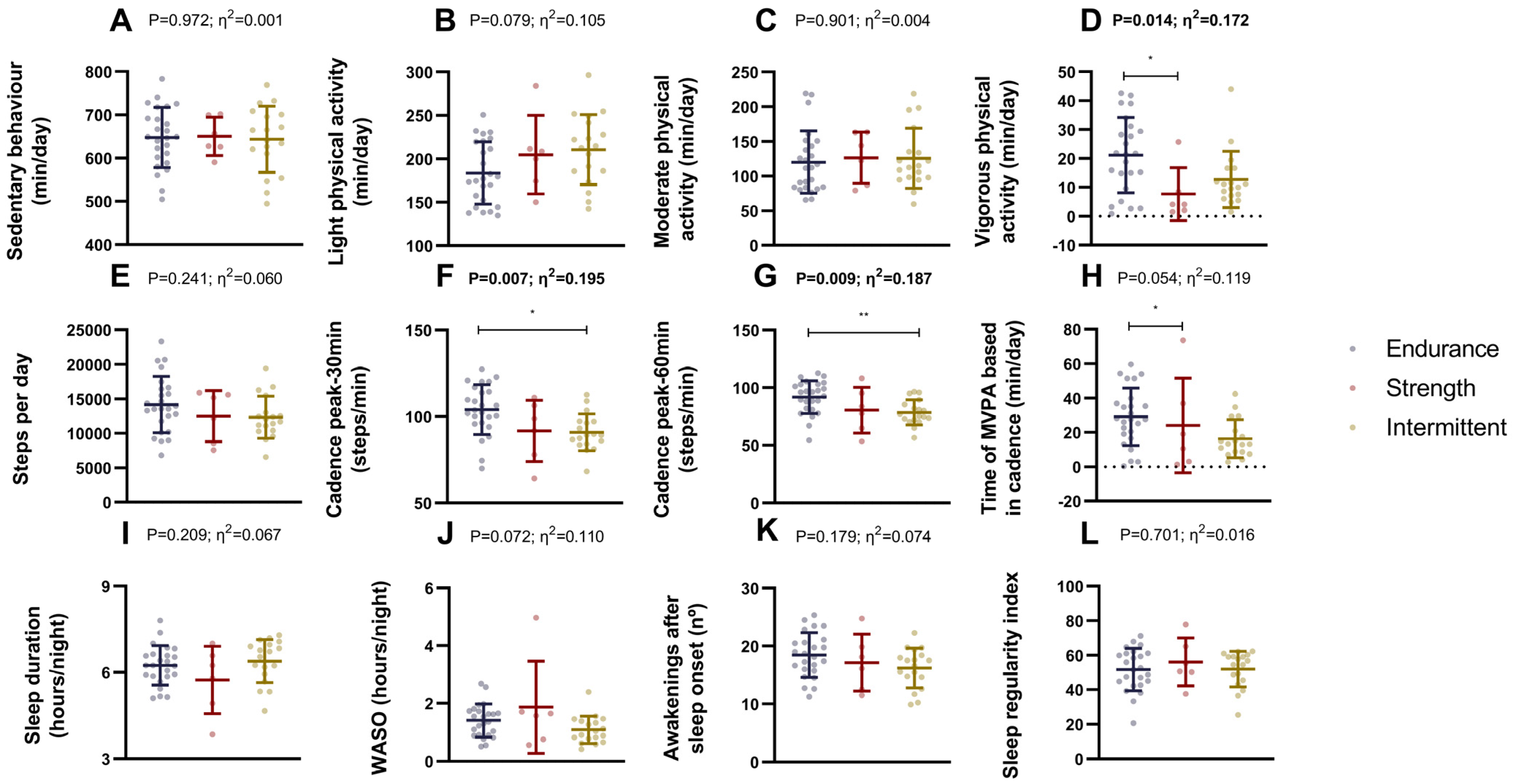Multidimensional Differences Between Athletes of Endurance, Strength, and Intermittent Sports: Body Composition, Diet, Resting Metabolic Rate, Physical Activity, Sleep Quality, and Subjective Well-Being
Abstract
1. Introduction
2. Materials and Methods
2.1. Participants and Study Design
2.2. Physiological and Psychological Assessments
2.2.1. Body Composition and Anthropometrics
2.2.2. Dietary Assessment
2.2.3. Resting Metabolic Rate
2.2.4. Handgrip Strength
2.2.5. Physical Activity, Sleep Quality
2.2.6. Subjective Evaluations of Health and Wellness
2.3. Statistical Analyses
3. Results
3.1. Differences in Body Composition Between Endurance, Strength, and Intermittent Sports Athletes
3.2. Differences in Dietary Intake Between Endurance, Strength, and Intermittent Sports Athletes
3.3. Differences in Resting Metabolic Rate and Handgrip Between Endurance, Strength, and Intermittent Sports Athletes
3.4. Differences in Physical Activity and Sleep Quality Between Endurance, Strength, and Intermittent Sports Athletes
3.5. Differences in Subjective Health and Wellness Between Endurance, Strength, and Intermittent Sports Athletes
4. Discussion
4.1. Differences in Body Composition
4.2. Differences in Dietary Intake
4.3. Differences in Resting Metabolic Rate and Handgrip Strength
4.4. Differences in Physical Activity Levels and Subjective Health
4.5. Strengths and Limitations
5. Conclusions
Supplementary Materials
Author Contributions
Funding
Institutional Review Board Statement
Informed Consent Statement
Data Availability Statement
Acknowledgments
Conflicts of Interest
References
- Mujika, I.; Halson, S.; Burke, L.M.; Balagué, G.; Farrow, D. An Integrated, Multifactorial Approach to Periodization for Optimal Performance in Individual and Team Sports. Int. J. Sports Physiol. Perform. 2018, 13, 538–561. [Google Scholar] [CrossRef] [PubMed]
- Burke, L.M.; Hawley, J.A. Swifter, Higher, Stronger: What’s on the Menu? Science 2018, 362, 781–787. [Google Scholar] [PubMed]
- Vaquero-Cristóbal, R.; Albaladejo-Saura, M.; Luna-Badachi, A.E.; Esparza-Ros, F. Differences in Fat Mass Estimation Formulas in Physically Active Adult Population and Relationship with Sums of Skinfolds. Int. J. Environ. Res. Public. Health 2020, 17, 7777. [Google Scholar] [CrossRef] [PubMed]
- Thomas, D.T.; Erdman, K.A.; Burke, L.M. Position of the Academy of Nutrition and Dietetics, Dietitians of Canada, and the American College of Sports Medicine: Nutrition and Athletic Performance. J. Acad. Nutr. Diet. 2016, 116, 501–528. [Google Scholar] [CrossRef]
- Cook, J.D.; Charest, J. Sleep and Performance in Professional Athletes. Curr. Sleep Med. Rep. 2023, 9, 56–81. [Google Scholar] [CrossRef]
- Hughes, D.C.; Ellefsen, S.; Baar, K. Adaptations to Endurance and Strength Training. Cold Spring Harb. Perspect. Med. 2018, 8, a029769. [Google Scholar] [CrossRef]
- Hostrup, M.; Bangsbo, J. Performance Adaptations to Intensified Training in Top-Level Football. Sports Med. 2023, 53, 577–594. [Google Scholar] [PubMed]
- Azmy, U.; Rahmaniah, N.; Renzytha, A.R.; Atmaka, D.R.; Pratiwi, R.; Rizal, M.; Adiningsih, S.; Herawati, L. Comparison of Body Compositions among Endurance, Strength, and Team Sports Athletes. Sport Mont 2023, 21, 45–50. [Google Scholar] [CrossRef]
- Bennell, K.L.; Malcolm, S.A.; Khan, K.M.; Thomas, S.A.; Reid, S.J.; Brukner, P.D.; Ebeling, P.R.; Wark, J.D.; Bennell, K. Bone Mass and Bone Turnover in Power Athletes, Endurance Athletes, and Controls: A 12-Month Longitudinal Study. Bone 1997, 20, 477–484. [Google Scholar] [CrossRef]
- Wardenaar, F.; Brinkmans, N.; Ceelen, I.; Van Rooij, B.; Mensink, M.; Witkamp, R.; De Vries, J. Macronutrient Intakes in 553 Dutch Elite and Sub-Elite Endurance, Team, and Strength Athletes: Does Intake Differ between Sport Disciplines? Nutrients 2017, 9, 119. [Google Scholar] [CrossRef]
- Scafoglieri, A.; Provyn, S.; Wallace, J.; Louis, O.; Tresignie, J.; Bautmans, I.; De, J.; Pieter, J. Whole Body Composition by Hologic QDR 4500/A DXA: System Reliability versus User Accuracy and Precision. In Applications and Experiences of Quality Control; InTech: London, UK, 2011. [Google Scholar]
- Covey, M.K.; Berry, J.K.; Hacker, E.D. Regional Body Composition: Cross-Calibration of DXA Scanners—QDR4500W and Discovery Wi. Obesity 2010, 18, 632–637. [Google Scholar] [CrossRef] [PubMed]
- Pietrobelli, A.; Rubiano, F.; St-Onge, M.P.; Heymsfield, S.B. New Bioimpedance Analysis System: Improved Phenotyping with Whole-Body Analysis. Eur. J. Clin. Nutr. 2004, 58, 1479–1484. [Google Scholar] [CrossRef]
- ISO 7250-1:2017; Basic Human Body Measurements for Technological Design—Part 1: Body Measurement Definitions and Landmarks. Spanish Association for Standardization: Madrid, Spain, 2017.
- Marfell-Jones, M.; Olds, T.; Stewart, A. International Standards for Anthropometric Assessment; International Society for the Advancement of Kinanthropometry (ISAK): Potchefstroom, South Africa, 2011; Volume 1. [Google Scholar]
- Anne Kerr, D. An Anthropometric Method for Fractionation of Skin, Adipose, Bone, Muscle and Residual Tissue Masses, in Males and Females Age 6 to 77 Years. Master’s Thesis, Simon Fraser University, Burnaby, BC, Canada, 1988. [Google Scholar]
- Alcantara, J.M.A.; Jurado-Fasoli, L.; Dote-Montero, M.; Merchan-Ramirez, E.; Amaro-Gahete, F.J.; Labayen, I.; Ruiz, J.R.; Sanchez-Delgado, G. Impact of Methods for Data Selection on the Day-to-Day Reproducibility of Resting Metabolic Rate Assessed with Four Different Metabolic Carts. Nutr. Metab. Cardiovasc. Dis. 2023, 33, 2179–2188. [Google Scholar] [CrossRef]
- Silvah, J.H.; de Lima, C.M.M.; Brandão, C.F.; Nicoletti, C.F.; Pfrimer, K.; Wichert-Ana, L.; Marchini, J.S. Indirect Calorimetry: Best Results with Close Monitoring of the Carbon Dioxide Fraction in Exhaled Air. Nutrire 2020, 45, 26. [Google Scholar] [CrossRef]
- Weir, J.B. de V New Methods for Calculating Metabolic Rate with Special Reference to Protein Metabolism. J. Physiol. 1949, 109, 1–9. [Google Scholar] [CrossRef] [PubMed]
- Ruiz-Ruiz, J.; Mesa, J.L.M.; Gutiérrez, A.; Castillo, M.J. Hand Size Influences Optimal Grip Span in Women but Not in Men. J. Hand Surg. 2002, 27, 897–901. [Google Scholar] [CrossRef]
- Migueles, J.H.; Rowlands, A.V.; Huber, F.; Sabia, S.; Van Hees, V.T. GGIR: A Research Community–Driven Open Source R Package for Generating Physical Activity and Sleep Outcomes From Multi-Day Raw Accelerometer Data. J. Meas. Phys. Behav. 2019, 2, 188–196. [Google Scholar] [CrossRef]
- van Hees, V.T.; Fang, Z.; Langford, J.; Assah, F.; Mohammad, A.; M da Silva, I.C.; Trenell, M.I.; White, T.; Wareham, N.J.; Brage, S.; et al. Autocalibration of Accelerometer Data for Free-Living Physical Activity Assessment Using Local Gravity and Temperature: An Evaluation on Four Continents. J. Appl. Physiol. 2014, 117, 738–744. [Google Scholar] [CrossRef]
- van Hees, V.T.; Renström, F.; Wright, A.; Gradmark, A.; Catt, M.; Chen, K.Y.; Löf, M.; Bluck, L.; Pomeroy, J.; Wareham, N.J.; et al. Estimation of Daily Energy Expenditure in Pregnant and Non-Pregnant Women Using a Wrist-Worn Tri-Axial Accelerometer. PLoS ONE 2011, 6, e22922. [Google Scholar] [CrossRef]
- van Hees, V.T.; Gorzelniak, L.; Dean León, E.C.; Eder, M.; Pias, M.; Taherian, S.; Ekelund, U.; Renström, F.; Franks, P.W.; Horsch, A.; et al. Separating Movement and Gravity Components in an Acceleration Signal and Implications for the Assessment of Human Daily Physical Activity. PLoS ONE 2013, 8, e61691. [Google Scholar] [CrossRef]
- Rowlands, A.V.; Maylor, B.; Dawkins, N.P.; Dempsey, P.C.; Edwardson, C.L.; Soczawa-Stronczyk, A.A.; Bocian, M.; Patterson, M.R.; Yates, T. Stepping up with GGIR: Validity of Step Cadence Derived from Wrist-Worn Research-Grade Accelerometers Using the Verisense Step Count Algorithm. J. Sports Sci. 2022, 40, 2182–2190. [Google Scholar] [CrossRef]
- Van Hees, V.T.; Sabia, S.; Anderson, K.N.; Denton, S.J.; Oliver, J.; Catt, M.; Abell, J.G.; Kivimäki, M.; Trenell, M.I.; Singh-Manoux, A. A Novel, Open Access Method to Assess Sleep Duration Using a Wrist-Worn Accelerometer. PLoS ONE 2015, 10, e142533. [Google Scholar] [CrossRef]
- Hildebrand, M.; Van Hees, V.T.; Hansen, B.H.; Ekelund, U. Age Group Comparability of Raw Accelerometer Output from Wrist-and Hip-Worn Monitors. Med. Sci. Sports Exerc. 2014, 46, 1816–1824. [Google Scholar] [CrossRef]
- Mohamed, O.; Freundlich, R.E.; Dakik, H.K.; Grober, E.D.; Najari, B.; Lipshultz, L.I.; Khera, M. The Quantitative ADAM Questionnaire: A New Tool in Quantifying the Severity of Hypogonadism. Int. J. Impot. Res. 2010, 22, 20–24. [Google Scholar] [CrossRef]
- Constaín, G.A.; Ricardo Ramírez, C.; Rodríguez-Gázquez, M.D.L.Á.; Álvarez Gómez, M.; Marín Múnera, C.; Agudelo Acosta, C. Validez y Utilidad Diagnóstica de La Escala EAT-26 Para La Evaluación Del Riesgo de Trastornos de La Conducta Alimentaria En Población Femenina de Medellín, Colombia. Aten Primaria 2014, 46, 283–289. [Google Scholar] [CrossRef]
- Lombardo, C.; Cerolini, S.; Esposito, R.M.; Lucidi, F. Psychometric Properties of a Silhouette Rating Scale Assessing Current and Ideal Body Size and Body Dissatisfaction in Adults. Eat. Weight Disord. 2022, 27, 1089–1097. [Google Scholar] [CrossRef]
- Lee, S.; Yun, H.-J.; Jeon, M.; Kang, M. Validating Athletes’ Subjective Performance Scale: A Rasch Model Analysis. Int. J. Appl. Sports Sci. 2023, 35, 238–250. [Google Scholar] [CrossRef]
- Macías, J.A.; Royuela, A. La versión española del Índice de Calidad de Sueño de Pittsburgh. Inf. Psiquiátricas 1996, 146, 465–472. [Google Scholar]
- Melin, A.; Tornberg, Å.B.; Skouby, S.; Faber, J.; Ritz, C.; Sjödin, A.; Sundgot-Borgen, J. The LEAF Questionnaire: A Screening Tool for the Identification of Female Athletes at Risk for the Female Athlete Triad. Br. J. Sports Med. 2014, 48, 540–545. [Google Scholar] [CrossRef]
- Vázquez-Espino, K.; Fernández-Tena, C.; Lizarraga-Dallo, M.A.; Farran-Codina, A. Development and Validation of a Short Sport Nutrition Knowledge Questionnaire for Athletes. Nutrients 2020, 12, 3561. [Google Scholar] [CrossRef]
- Brun, J.F. The Overtraining: To a System of Evaluation Usable by routine Examination. In Proceedings of the Science and Sports; Elsevier Masson SAS: Amsterdam, The Netherlands, 2003; Volume 18, pp. 282–286. [Google Scholar]
- Mountjoy, M.; Ackerman, K.E.; Bailey, D.M.; Burke, L.M.; Constantini, N.; Hackney, A.C.; Heikura, I.A.; Melin, A.; Pensgaard, A.M.; Stellingwerff, T.; et al. 2023 International Olympic Committee’s (IOC) Consensus Statement on Relative Energy Deficiency in Sport (REDs). Br. J. Sports Med. 2023, 57, 1073–1097. [Google Scholar] [CrossRef]
- Campa, F.; Toselli, S.; Mazzilli, M.; Gobbo, L.A.; Coratella, G. Assessment of Body Composition in Athletes: A Narrative Review of Available Methods with Special Reference to Quantitative and Qualitative Bioimpedance Analysis. Nutrients 2021, 13, 1620. [Google Scholar] [CrossRef]
- Walker, S.; von Bonsdorff, M.; Cheng, S.; Häkkinen, K.; Bondarev, D.; Heinonen, A.; Korhonen, M.T. Body Composition in Male Lifelong Trained Strength, Sprint and Endurance Athletes and Healthy Age-Matched Controls. Front. Sports Act. Living 2023, 5, 1295906. [Google Scholar] [CrossRef]
- Rosen, E.D.; Spiegelman, B.M. What We Talk about When We Talk about Fat. Cell 2014, 156, 20–44. [Google Scholar] [CrossRef]
- Domaradzki, J.; Koźlenia, D. The Performance of Body Mass Component Indices in Detecting Risk of Musculoskeletal Injuries in Physically Active Young Men and Women. PeerJ 2022, 10, e12745. [Google Scholar] [CrossRef]
- Campa, F.; Matias, C.; Gatterer, H.; Toselli, S.; Koury, J.C.; Andreoli, A.; Melchiorri, G.; Sardinha, L.B.; Silva, A.M. Classic Bioelectrical Impedance Vector Reference Values for Assessing Body Composition in Male and Female Athletes. Int. J. Environ. Res. Public Health 2019, 16, 5066. [Google Scholar] [CrossRef]
- Campa, F.; Thomas, D.M.; Watts, K.; Clark, N.; Baller, D.; Morin, T.; Toselli, S.; Koury, J.C.; Melchiorri, G.; Andreoli, A.; et al. Reference Percentiles for Bioelectrical Phase Angle in Athletes. Biology 2022, 11, 264. [Google Scholar] [CrossRef]
- Garthe, I.; Raastad, T.; Refsnes, P.E.; Sundgot-Borgen, J. Effect of Nutritional Intervention on Body Composition and Performance in Elite Athletes. Eur. J. Sport Sci. 2013, 13, 295–303. [Google Scholar] [CrossRef]
- Slater, G.; Phillips, S.M. Nutrition Guidelines for Strength Sports: Sprinting, Weightlifting, Throwing Events, and Bodybuilding. J. Sports Sci. 2011, 29, S67–S77. [Google Scholar] [CrossRef]
- Goolsby, M.A.; Boniquit, N. Bone Health in Athletes: The Role of Exercise, Nutrition, and Hormones. Sports Health 2017, 9, 108–117. [Google Scholar] [CrossRef]
- Stunes, A.K.; Brobakken, C.L.; Sujan, M.A.J.; Aagård, N.; Brevig, M.S.; Wang, E.; Syversen, U.; Mosti, M.P. Acute Effects of Strength and Endurance Training on Bone Turnover Markers in Young Adults and Elderly Men. Front. Endocrinol. 2022, 13, 915241. [Google Scholar] [CrossRef]
- Bonewald, L.F. The Amazing Osteocyte. J. Bone Miner. Res. 2011, 26, 229–238. [Google Scholar] [CrossRef]
- Hong, A.R.; Kim, S.W. Effects of Resistance Exercise on Bone Health. Endocrinol. Metab. 2018, 33, 435–444. [Google Scholar] [CrossRef]
- Heydenreich, J.; Kayser, B.; Schutz, Y.; Melzer, K. Total Energy Expenditure, Energy Intake, and Body Composition in Endurance Athletes Across the Training Season: A Systematic Review. Sports Med. Open 2017, 3, 8. [Google Scholar]
- Naderi, A.; Gobbi, N.; Ali, A.; Berjisian, E.; Hamidvand, A.; Forbes, S.C.; Koozehchian, M.S.; Karayigit, R.; Saunders, B. Carbohydrates and Endurance Exercise: A Narrative Review of a Food First Approach. Nutrients 2023, 15, 1367. [Google Scholar] [CrossRef] [PubMed]
- Nestorova Brazanska, M.; Spirkovska Vangelovska, B.; Dejanova, B.; Karagjozova, I.; Pluncevic Gligoroska, J. The Resting Metabolic Values Related to Different Sport Disciplines. Res. Phys. Educ. Sport Health 2022, 11, 147–151. [Google Scholar] [CrossRef]
- Thompson, J.; Manore, M.M. Predicted and Measured Resting Metabolic Rate of Male and Female Endurance Athletes. J. Am. Diet. Assoc. 1996, 96, 30–34. [Google Scholar] [CrossRef]
- Boissy, P.; Bourbonnais, D.; Carlotti, M.M.; Gravel, D.; Arsenault, B.A. Maximal Grip Force in Chronic Stroke Subjects and Its Relationship to Global Upper Extremity Function. Clin. Rehabil. 1999, 13, 354–362. [Google Scholar] [CrossRef]
- Goshozono, M.; Miura, N.; Torii, S.; Taguchi, M. Characteristics of Non-Exercise Activity Thermogenesis in Male Collegiate Athletes under Real-Life Conditions. Front. Sports Act. Living 2024, 6, 1326890. [Google Scholar] [CrossRef]
- Keogh, J.W.L.; Winwood, P.W. The Epidemiology of Injuries Across the Weight-Training Sports. Sports Med. 2017, 47, 479–501. [Google Scholar] [CrossRef]
- Davies, M.; Lawrence, T.; Edwards, A.; Mckay, C.; Lecky, F.E.; Stokes, K.A.; Williams, S. Sport-Related Major Trauma Incidence in Young People and Adults in England and Wales: A National Registry-Based Study. Inj. Prev. 2023, 30, 60–67. [Google Scholar] [CrossRef]




| Endurance Athletes (n = 40) | Strength Athletes (n = 12) | Intermittent Athletes (n = 25) | ||||
|---|---|---|---|---|---|---|
| Mean | SD | Mean | SD | Mean | SD | |
| Age (years) | 23.7 | 6.5 | 29.3 | 3.7 | 25.00 | 4.9 |
| Sex (n; %) | ||||||
| Male (n, %) | 25 | 62.5 | 8 | 66.6 | 16 | 64.0 |
| Female (n, %) | 15 | 37.5 | 4 | 33.4 | 9 | 36.0 |
| Weight (kg) | 64.0 | 8.4 | 79.9 | 11.6 | 75.8 | 8.6 |
| Height (cm) | 171.6 | 8.8 | 174.0 | 7.1 | 174.3 | 8.1 |
| BMI (kg/m2) | 21.7 | 1.7 | 26.3 | 2.6 | 24.96 | 2.4 |
| Training experience (years) | 8.8 | 5.5 | 6.8 | 6.0 | 10.1 | 5.7 |
| Competition level | ||||||
| Regional (n,%) | 17 | 42.5 | 5 | 41.7 | 15 | 60 |
| National (n, %) | 22 | 55 | 7 | 58.3 | 7 | 28 |
| International (n, %) | 1 | 2.5 | 0 | 0 | 2 | 8 |
| Endurance Athletes | Strength Athletes | Intermittent Athletes | One-Way ANOVA | ||||||||
|---|---|---|---|---|---|---|---|---|---|---|---|
| Mean | SD | n | Mean | SD | n | Mean | SD | n | p Value | η2 | |
| ADAM-Q (Total score) | 2.12 | 2.36 | 26 | 2.13 | 1.55 | 8 | 1.63 | 2.22 | 16 | 0.764 | 0.011 |
| EAT-26 (Total score) | 11.56 | 7.65 | 39 | 10.18 | 5.76 | 11 | 12.58 | 8.47 | 24 | 0.687 | 0.011 |
| SRS (Total score) | −0.18 | 1.04 | 38 | −0.17 | 0.72 | 12 | 0.04 | 0.93 | 25 | 0.646 | 0.012 |
| ASPS (Total score) | 42.03 | 10.96 | 39 | 34.83 | 9.65 | 12 | 40.96 | 11.57 | 25 | 0.143 | 0.052 |
| PSQI (Total score) | 5.45 | 2.13 | 38 | 6.67 | 3.73 | 12 | 6.87 | 4.65 | 23 | 0.235 | 0.041 |
| LEAF-Q (Total score) | 7.07 | 6.15 | 14 | 4.50 | 2.65 | 4 | 12.22 | 6.32 | 9 | 0.062 | 0.207 |
| LEAF-Q (Injuries score) | 1.64 | 2.68 | 14 | 1.75 | 3.50 | 4 | 4.78 | 2.44 | 9 | 0.033 | 0.247 |
| LEAF-Q (GI function score) | 2.79 | 2.78 | 14 | 1.50 | 0.58 | 4 | 3.22 | 2.99 | 9 | 0.571 | 0.046 |
| LEAF-Q (Menstrual cycle score) | 2.64 | 1.69 | 14 | 1.25 | 1.50 | 4 | 4.22 | 3.67 | 9 | 0.136 | 0.153 |
| NUKYA (Total score) | 22.46 | 6.71 | 39 | 23.08 | 8.85 | 12 | 24.40 | 8.29 | 25 | 0.611 | 0.013 |
| Overtraining (Total score) | 8.97 | 8.67 | 38 | 12.50 | 8.76 | 10 | 11.78 | 11.30 | 23 | 0.413 | 0.026 |
| RESTQ-76—General stress score | 2.23 | 2.19 | 39 | 2.30 | 2.00 | 10 | 3.78 | 6.13 | 23 | 0.301 | 0.034 |
| RESTQ-76—Emotional stress score | 3.26 | 2.83 | 39 | 3.90 | 2.51 | 10 | 3.70 | 4.39 | 23 | 0.811 | 0.006 |
| RESTQ-76—Social stress score | 2.82 | 2.45 | 39 | 3.70 | 2.21 | 10 | 3.57 | 4.83 | 23 | 0.615 | 0.014 |
| RESTQ-76—Conflicts/pressure score | 6.56 | 3.65 | 39 | 6.80 | 5.88 | 10 | 6.52 | 5.31 | 23 | 0.986 | 0.000 |
| RESTQ-76—Fatigue score | 6.77 | 3.14 | 39 | 6.50 | 3.54 | 10 | 8.04 | 6.12 | 23 | 0.479 | 0.021 |
| RESTQ-76—Lack of energy score | 4.69 | 3.12 | 39 | 5.00 | 3.40 | 10 | 5.39 | 4.49 | 23 | 0.767 | 0.008 |
| RESTQ-76—Physical alterations score | 3.95 | 2.76 | 39 | 3.10 | 1.37 | 10 | 4.43 | 4.19 | 23 | 0.538 | 0.018 |
| RESTQ-76—Success score | 11.00 | 5.32 | 39 | 11.70 | 4.60 | 10 | 11.13 | 5.11 | 23 | 0.929 | 0.002 |
| RESTQ-76—Social recovery score | 13.23 | 4.74 | 39 | 11.90 | 4.79 | 10 | 13.57 | 5.94 | 23 | 0.690 | 0.011 |
| RESTQ-76—Physical recovery score | 12.10 | 4.69 | 39 | 10.60 | 3.24 | 10 | 12.48 | 5.45 | 23 | 0.579 | 0.016 |
| RESTQ-76—General well-being score | 16.10 | 4.99 | 39 | 13.90 | 5.15 | 10 | 15.61 | 6.39 | 23 | 0.531 | 0.018 |
| RESTQ-76—Sleep Quality score | 10.44 | 4.44 | 39 | 10.90 | 4.58 | 10 | 10.52 | 4.25 | 23 | 0.957 | 0.001 |
| RESTQ-76—Alterations of rest periods score | 4.33 | 3.43 | 39 | 4.30 | 2.63 | 10 | 3.61 | 3.00 | 23 | 0.676 | 0.011 |
| RESTQ-76—Emotional fatigue score | 3.56 | 4.27 | 39 | 2.40 | 1.84 | 10 | 4.30 | 3.61 | 23 | 0.419 | 0.025 |
| RESTQ-76—Injuries score | 6.23 | 4.31 | 39 | 8.20 | 4.66 | 10 | 7.13 | 4.35 | 23 | 0.407 | 0.026 |
| RESTQ-76—Being in shape score | 13.64 | 5.20 | 39 | 13.50 | 5.68 | 10 | 13.48 | 5.46 | 23 | 0.992 | 0.000 |
| RESTQ-76—Personal fulfillment score | 11.28 | 5.25 | 39 | 12.90 | 5.02 | 10 | 11.74 | 5.45 | 23 | 0.687 | 0.011 |
| RESTQ-76—Self-efficacy score | 12.95 | 5.31 | 39 | 14.10 | 6.24 | 10 | 12.30 | 5.93 | 23 | 0.702 | 0.010 |
| RESTQ-76—Self-regulation score | 14.21 | 6.36 | 39 | 14.70 | 7.39 | 10 | 13.96 | 5.94 | 23 | 0.954 | 0.001 |
Disclaimer/Publisher’s Note: The statements, opinions and data contained in all publications are solely those of the individual author(s) and contributor(s) and not of MDPI and/or the editor(s). MDPI and/or the editor(s) disclaim responsibility for any injury to people or property resulting from any ideas, methods, instructions or products referred to in the content. |
© 2025 by the authors. Licensee MDPI, Basel, Switzerland. This article is an open access article distributed under the terms and conditions of the Creative Commons Attribution (CC BY) license (https://creativecommons.org/licenses/by/4.0/).
Share and Cite
Rueda-Cordoba, M.; Martin-Olmedo, J.J.; Espinar, S.; Ruiz, J.R.; Jurado-Fasoli, L. Multidimensional Differences Between Athletes of Endurance, Strength, and Intermittent Sports: Body Composition, Diet, Resting Metabolic Rate, Physical Activity, Sleep Quality, and Subjective Well-Being. Nutrients 2025, 17, 1172. https://doi.org/10.3390/nu17071172
Rueda-Cordoba M, Martin-Olmedo JJ, Espinar S, Ruiz JR, Jurado-Fasoli L. Multidimensional Differences Between Athletes of Endurance, Strength, and Intermittent Sports: Body Composition, Diet, Resting Metabolic Rate, Physical Activity, Sleep Quality, and Subjective Well-Being. Nutrients. 2025; 17(7):1172. https://doi.org/10.3390/nu17071172
Chicago/Turabian StyleRueda-Cordoba, Marcos, Juan J. Martin-Olmedo, Sergio Espinar, Jonatan R. Ruiz, and Lucas Jurado-Fasoli. 2025. "Multidimensional Differences Between Athletes of Endurance, Strength, and Intermittent Sports: Body Composition, Diet, Resting Metabolic Rate, Physical Activity, Sleep Quality, and Subjective Well-Being" Nutrients 17, no. 7: 1172. https://doi.org/10.3390/nu17071172
APA StyleRueda-Cordoba, M., Martin-Olmedo, J. J., Espinar, S., Ruiz, J. R., & Jurado-Fasoli, L. (2025). Multidimensional Differences Between Athletes of Endurance, Strength, and Intermittent Sports: Body Composition, Diet, Resting Metabolic Rate, Physical Activity, Sleep Quality, and Subjective Well-Being. Nutrients, 17(7), 1172. https://doi.org/10.3390/nu17071172







